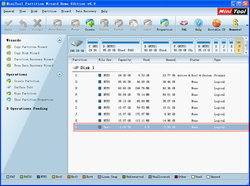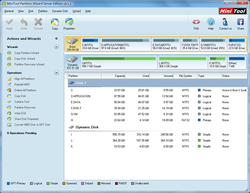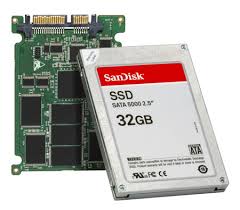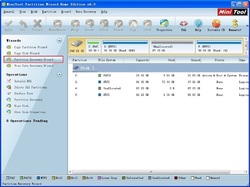The emergence of Windows server 2008 brings a host of surprises to server operating system users in view of stability, security performance, manageability, and network services, resulting great popularity. Still many are lured but reluctant to employ Windows server 2008 due to fear of compatibility concern. For example, disk management software compatible with previous operating systems such as Windows server 2003 and Windows XP may be incompatible with Windows Server 2008. Therefore, I would like to recommend user a disk management software by the name of MiniTool Partition Wizard which perfectly supports Windows Server 2008. Windows Server 2008 is built from the same code base as Windows Vista; therefore, it shares much of the same architecture and functionality. Since the code base is common, it automatically comes with most of the technical, security, management and administrative features new to Windows Vista such as the rewritten networking stack (native IPv6, native wireless, speed and security improvements); improved image-based installation, deployment and recovery; improved diagnostics, monitoring, event logging and reporting tools; new security features such as BitLocker and ASLR; improved Windows Firewall with secure default configuration; .NET Framework 3.0 technologies, specifically Windows Communication Foundation, Microsoft Message Queuing and Windows Workflow Foundation; and the core kernel, memory and file system improvements. Processors and memory devices are modeled as Plug and Play devices, to allow hot-plugging of these devices. This allows the system resources to be partitioned dynamically using Dynamic Hardware Partitioning; each partition has its own memory, processor and I/O host bridge devices independent of other partitions. Developed by MiniTool Solution Ltd., MiniTool Partition Wizard is a powerful partition magic with user-friendly interfaces, easy operations and incredible functions that is perfectly compatible with Windows Server 2003, Windows Server 2008, Windows 95, Windows 98, Windows 2000, Windows 2003, Windows XP, Windows Vista, Windows 7 and supports FAT12, FAT16, FAT32, NTFS4, and NTFS5. Furthermore, MiniTool Partition Wizard can also manage GPT partition and convert dynamic disk to basic disk. Launch MiniTool Partition Wizard to merge partitions: Select any partition and click " Merge" at the toolbar. Select the partition to be expanded and click " Next". Note that those two partitions to be merged must be NTFS partitions or use should employ " Convert FAT to NTFS" to first convert FAT32 to NTFS. Select another partition to be merged to the previously-selected partition as a folder and specify a name for this folder. After that, click " Finish" Now user could notice those two partitions have been successfully merged in this preview interface. Then, user should still click " Apply" to really execute all pending operations listed at the lower-left corner of this interface.
Microsoft's Windows Azure Backup Service, which stores data from Windows Servers in the Azure cloud for backup and recovery purposes, is now generally available, Scott Guthrie, Microsoft's corporate vice president of Windows Azure, said in a blog post. "This release is now live in production, backed by an enterprise SLA [service-level agreement], supported by Microsoft Support, and is ready to use for production scenarios," Guthrie said in the blog post. Windows Azure Backup Service also backs up data from System Center Data Protection Manager and Windows Server Essentials and encrypts it onsite before sending it to the cloud, Guthrie said in the blog post. Rand Morimoto, president of Convergent Computing, an Oakland, Calif.-based Microsoft partner, said cloud storage makes sense for many customers because it spares them the time and expense of backing up data and keeping track of it. "Storage is the number one big ticket spending item right now as data is retained across pretty much every part of an organization," Morimoto said in an email. "We've had many of our customers move to cloud based storage for longer term archiving." Microsoft is charging customers based on the amount of data they store on the Azure cloud. It's offering pay-as-you-go and pre-paid options, both of which let customers store up to 5 GB per month for free. For pay-as-you-go, Microsoft is charging 25 cents per GB per month as part of a promotion that runs through the end of November. Starting Dec. 1, Azure storage will cost 50 cents per GB monthly. For a 6-month or 12-month commitment, Microsoft is charging 17 cents to 20 cents per GB per month until Nov. 30, and 34 cents to 40 cents per GB per month after that. Meanwhile, Microsoft also released the public preview of Windows Azure Hyper-V Recovery Manager (HRM), a new service that handles offsite replication of data from System Center Virtual Machine Manager 2012 SP1 and System Center Virtual Machine Manager 2012 R2 private clouds. Guthrie, in the blog post, noted that application data in HRM remains in the customer's on-premise replication channel, with only encrypted metadata being sent back and forth to Azure. Data security is one of the biggest obstacles keeping enterprises from using the public cloud, and Microsoft is trying to show that it has put a lot of thought into this aspect of Azure. Microsoft is also providing Windows Azure Active Directory, its cloud-hosted user partition management service, to every Windows Azure account. Customers can keep Azure Active Directory in the cloud or synch it with their on-premise Active Directory, Guthrie said in the blog post.
Windows Server 2003 is an excellent server edition operating system released by Microsoft on March 28th, 2003. Compared with Windows 2000, Windows Server 2003 has a lot of improvement like improvement on Active Directory, operation and management of Group Police and so on. It is highly appreciated by many server users due to its higher security, reliability, availability and expandability. When users enjoy those advantages, they may encounter lots of problems. One of them is the partition management. Since disk management tool built in Windows Server 2003 has simplex function, many users are looking for some better Windows Server 2003 partition magic for partition management while there are some other users familiar with code using the command " DiskPart" to manage disks. Which method is better? We will make a comparison in partition of Windows Server 2003. Using the command "DiskPart" to extend partition in Windows Server 2003User need not to install the software. The detailed procedures are following. 1. Click " Start". 2. Select " Command Prompt". 3. Input " diskpart" in the popup command line interface and press " Enter" 4. Input " list volume" and press " Enter" to view partition status. 5. Input " select volume x" to select the partition that will be expanded (X is the number of partition which needs to be expanded). 6. Input " extend" to finish partition expansion. NOTE: If users want to extend partition by using "DiskPart", there must be unallocated space adjacent to the partition that will be extended We can save installation procedure by using the command " DiskPart" in Windows Sever 2003, but inputting command code is difficult and complicated for users who are unfamiliar with code. And Windows Server 2003 partition magic is easier to reduce the possibility of accidental operation.
Dual boot Windows XP Windows 7 is the dream of most computer users. Windows XP is the most stable operating system of Microsoft. It has excellent compatibility with almost all software. Windows 7 is the newest operating system of Microsoft. It attracts users by its perfect experience. To own these two operating systems at the same time, dual boot Windows XP and Windows 7 is the best choice.
To realize dual boot Windows XP and Windows 7, we should install them both to the computer. At the same time, we need to pay attention to that installing operating system is not like installing third-party software. Some users cannot dual boot Windows XP and Windows 7 as a result of ignoring details when installing. The following are some points needed to be noticed when installing:
1. Before installing Windows XP and Windows 7, we should know about them first. At least, we should know about the system requirement. Windows 7 is a brand-new operating system after Windows XP. It has higher requirement on computer configuration. Therefore, to install them both, we should consider about computer configuration.
2. We should also consider the version issue. Windows 7 is higher so we should install Windows XP and then Windows 7. Otherwise we can not realize dual boot Windows XP and Windows 7.
3. Windows XP and Windows 7 should be installed to different partitions because different operating systems may disturb each other if they are in the same partition. Once the partition is damaged, neither Windows XP nor Windows 7 can start.
4. Windows XP and Windows 7 have different sizes. When creating partition, we should consider the size of operating system, the size need for applications and software, as well as the size of operating systems need to operate normally.
5. Set both Windows XP and Windows 7 system partitions as primary partitions. In addition, set one of the primary partitions as active partition. There can be only one active partition. Generally, we set Windows XP system partition as active partition.
These five points need our attention when we install the two operating systems. What's more, what we need is an excellent partition magic to realize dual boot Windows XP and Windows 7. When installing, MiniTool Partition Wizard will give you the best help. It can create partition, set primary partition and active partition, as well as resize partition easily.
MiniTool Partition Wizard creates condition for dual boot Windows XP Windows 7
The first step is to create two reasonable partitions for Windows XP and Windows 7. If there is not enough space in disk, we can use MiniTool Partition Wizard to delete partition or resize partition and then get some free space. With this free space we can create new partitions.
This is the interface of MiniTool Partition Wizard to create new partition. Through dragging the partition handle or inputting values in the textboxes to create partition you need. Remember to set the partitions as primary partitions. After creating, set one of them as active partition. For more detailed information please visit the official website of MiniTool Partition Wizard: http://www.partitionwizard.com.
 Unallocated space in disk refers to a kind of space which is not created with partition currently. They may have complete files, fragments and other files generated by some utility software and operating system. Just like the following interface, the part chose by red box is the unallocated space. It is always said that unallocated space emerges because of the loss of partition. If user wants to recover datafile in unallocated space completely, you can take my suggestion using MiniTool Partition Wizard which is a professional partition magic. This is because it is easy to operate MiniTool Partition Wizard, and the most important point is that it is completely free for individual and family users. Before demonstrating how to use MiniTool Partition Wizard, we need to learn something about partition. With the development of computer, partition technology steps forward constantly. What is called partition technology is actually such kind of technology with which we can divide the disk into multiple working units which are called partitions. In today's world, information technology tends to be a trend. People use partition every day; however, they do not know the advantages brought by partition clearly. Now, we are making a summary for advantages carried by partition: 1. It is convenient for us to make a plan for disk and to manage files. 2. Partitioning disk is conducive to prevent virus and secure data. 3. It is good to enhance the utilization of disk space to part the disk efficiently. 4. It can boost the running efficiency of computers. 5. It can distribute different limits of authority for different users. 6. We must operate in different partitions when we make mirror image partition. 7. It can have creating different file system realized so as to manage files preferably. That is a brief introduction for partition. Now, I am demonstrating how to use MiniTool Partition Wizard to recover lost partition. Before using MiniTool Partition Wizard, we need to make a preparation. At first, we need to have this software.Download this software on URL http://www.partitionwizard.com, and then install it on your computer after downloading successfully. You can start recovering partition after notarizing installation successfully. Open and run MiniTool Partition Wizard, and then you can see the following interface: Select the disk and click " Partition Recovery Wizard" at the action panel under " Wizards". This is a welcome interface which tells us this function can recover lost or deleted partition. With choosing " Next", we enter into the next step. In this interface, we can choose the right disk where lost partition needs to be recovered. Click " Next", we enter into the next step. In this interface, we select the scope type of disk scanning. Here, we select " Full Disk" to seek. Click " next", we enter into the next step. In this interface, we select method of scanning, and then select click " Next" to enter into the next step. This interface shows us the state of losing and existing partition. Here, we need to select partitions needing to be recovered and currently existing partition, click " Finish" after checking all partitions to go back to main interface. On this interface, partitions have been recovered. Next, we need to assign drive letter for partition by employing " Change Drive Letter".
 MiniTool recently released partition wizard 8.1.1. This new edition was reported to have better performance with most of the bugs fixed.
MiniTool Partition Wizard is a Windows based PC and Server partition manager software.
The main functions are:
 Today there are more and more computer users who are choosing to save the important electronic data from their laptop or netbook onto Solid State Drives in preference to standard traditional hard disk drive units. And to be honest this really isn't much of a surprise. These advanced SSD drives are much more efficient and durable in use. But not many of us, even though we use computers every day, actually know how these new storage devices work! And how many of us know just how quickly this new technology for computer storage is improving? Because these new solid state devices are not like the hard drives we are used to and do not rely on any moving parts at all they are not as likely to be damaged very easily. This new robustness will provide you with extra protection to your important data and photo images that all of us keep on our computers a lot of the time. Up until earlier this year most new ssd drives were purchased as an exact replacement for a standard hard disk drive that still exist in most of today's personal computers. The main market for these types of disk replacement has been for notebook computers. For all of us computer users who really do not understand the basics of how a solid state drive works then it is a good idea to have a quick look at the main features and benefits that this new technology now provides. Most solid state drives typically are provided in just three different sizes. They come in 1.8, 2.5 and 3.5 inches versions. Each size is small and compact enough to be installed in the smaller and thinner types of computers, such as netbooks, which are becoming very popular today.
You know how important a hard drive is and most of your computer software is placed on a hard drive. But how about program FOR your hard-drive - private disks, partition managers, disk defragmenters? Here is the gather on the hottest instruments. Dekart Private Disk results in one or more internet hard disk drives on your disk drive and/or other additional storage space units. Once a user creates a virtual encrypted disk, that disk is assigned a new drive letter and appears to the user like any other system drive. If the storage is fastened, the data is easily coded and decrypted if the user is currently writing or states this data correspondingly. Dekart Private Disk encrypts and decrypts most data stored on the encrypted disk with nearly no effectiveness penalty. Partition wizard is suited for both pros and home consumers. It an excellent partition manager tool and the basic partitioning functions are: resize, convert, move, split, copy, and recover partitions. You can certainly regain by accident lost partitions. It lets you install several separate operating systems on one hard drive. The partition wizard bootable CD is integrated into the program. Bright Partition technology that has all operations without losing a single byte of data. Supported file systems are FAT 16/32, NTFS, Ext2/3FS, and ReiserFS.
 Because of the promotion of Microsoft, NTFS partition has gradually replaced FAT32 partition, becoming the most popular partition file format. However, when we feast on the convenience and safety brought by NTFS partition, we may encounter NTFS partition loss. As the lost partition may store important files, we certainly hope to find them back. How to recover lost NTFS partition? MiniTool Partition Wizard, providing " Partition Recovery Wizard", is a good choice to recover NTFS partition. NTFS is developed for Windows NT and the later editions of operating systems. Compared with other file systems, it has many advantages. 1. Provides file encryption function to improve data security. 2. Possesses better disk compression ability. 3. Supports maximum disk of 2TB. And along with the increase of disk capacity, performance of NTFS will not reduce as FAT does. 4. Allows access permission to single file and folder. 5. Has self-repairing function without users operating disk repair program in NTFS. 6. B-Tree structure in NTFS makes file access faster and more convenient for users. 7. Single file and folder can be compressed in NTFS. 8. Supports active directory and domain. 9. Supports sparse file. 10. Supports disk quota. " Partition Recovery Wizard" function module of MiniTool Partition Wizard released by MiniTool Solution Ltd., is specially designed to recover accidentally deleted or lost partitions. Take NTFS partition for example, if it is deleted or lost by accident, the record of NTFS partition in partition table will be eliminated or changed. Therefore, the operating system can not find it when users are to open the NTFS partition. However, during NTFS hard disk recovery, the function module " Partition Recovery Wizard" of MiniTool Partition Wizard can skip the partition table to scan disk directly. And then it will find the lost NTFS partition and record it in partition table again. After the process is finished, the operating system will find the NTFS partition and access its data. To recover lost NTFS partition, please download MiniTool Partition Wizard on the website: http://www.partitionwizard.com/ Run it after installation and the main interface will be shown. In this interface, please click function module " Partition Recovery Wizard" to recover lost NTFS partition by following the prompts provided in every step. And the lost NTFS partition and data can be recovered quickly. NOTE: Select all partitions that are to be saved, otherwise it will be lost. MiniTool Partition Wizard is not only a kind of powerful partition recovery software but also reliable professional partition magic capable of recovering lost NTFS partition and providing better management for disk and partition due to it comprehensive disk management functions like merge partition, resize partition, wipe partition, surface test and rebuild MBR etc.
 During the using process of Windows 8 computer using UEFI mainboard, lots of Windows 8 computer users sometimes need to copy disk under Windows 8. Copy disk is not very troublesome, because users can easily complete this operation with partition magic software having Copy Partition function. Since users adopt the Windows 8 computer using UEFI mainboard, they find copy disk is not very easy now. On current partition management software market, the vast majority of software has serious functional defects and doesn’t support management on GPT disk, so more and more Windows 8 users are looking for a piece of professional partition magic software supporting GPT partition management. Now, the dreams come true. As the partition management software technology becomes more mature, the famous Canada software developing company MiniTool Solution Ltd. launches a piece of professional partition magic software MiniTool Partition Wizard after great efforts. This partition magic software not only can complete all partition management operations on MBR disk, but also supports partition management operations on GPT disk. Therefore, as long as users adopt this professional partition magic software, you can copy GPT disk under Windows 8 with ease. Use MiniTool Partition Wizard to copy GPT disk under Windows 8If users want to use MiniTool Partition Wizard to copy GPT disk under Windows 8, please firstly visit the official website of this software http://www.partitionwizard.com, then download and install it. After that, start this software to see interface below: After entering the main interface of this professional partition magic software MiniTool Partition Wizard, if users want to copy GPT disk under Windows 8, choose the partition to copy and choose " Copy Disk" functional module. Then, users will enter the operating interface. After that, choose the resource disk and click " Next" to enter interface below: Here, users need to choose disk copying method from three choices: 1. Fit partitions to entire disk. 2. Copy partitions without resize. 3. Copy partitions minimum size. After that, click “ Next” to return to the main interface. Users can preview that GPT disk is copied. Click " Apply" and wait until this software completes all operations and then users thoroughly copy GPT disk with MiniTool Partition Wizard.
|





 RSS Feed
RSS Feed